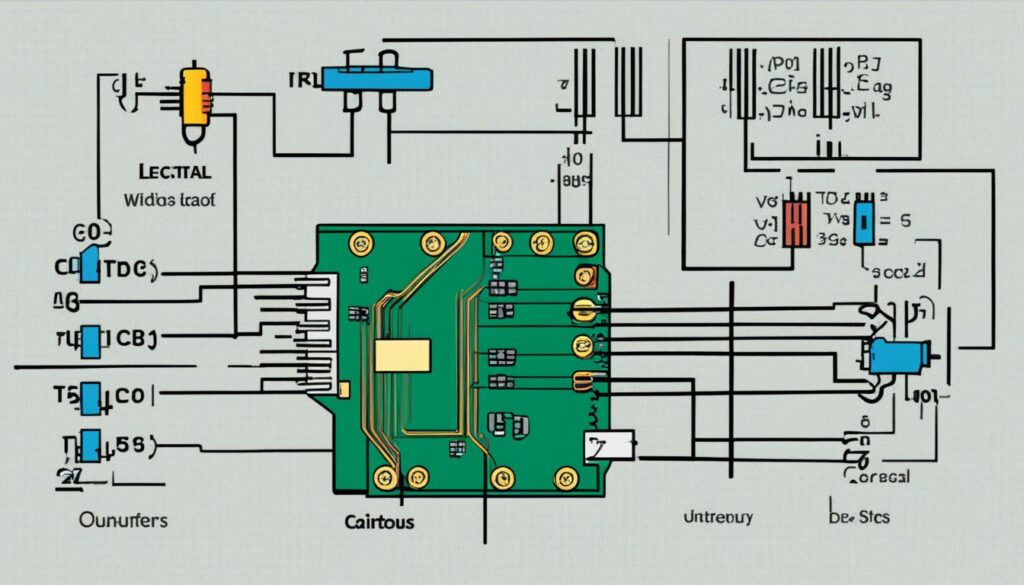Welcome to our comprehensive guide on counters in digital circuits. In the world of technology, counters are crucial components that play a significant role in various applications. In this article, we will explore the intricacies of counters, their applications, and their functions.
Counters, as sequential logic circuits, are capable of generating a sequence of binary numbers. They are widely used in digital circuits for tasks such as frequency division, timing, and memory addressing. Understanding counters is fundamental to harnessing their power in designing advanced digital systems.
There are different types of counters, each suitable for specific applications. From ripple counters to synchronous counters, up counters to down counters, we will delve into the characteristics and functionalities of each type.
Throughout this article, our aim is to provide you with a comprehensive understanding of counters in digital circuits. We will discuss their operation, advantages, disadvantages, and real-world applications. Counters are versatile and find usage in applications such as frequency counters, digital clocks, shift registers, and event counting.
By the end of this article, you will have the knowledge and insights necessary to harness the power of counters and utilize them effectively in various technological advancements. So, let’s dive into the world of counters and explore their capabilities in digital circuits.
Table of Contents
Understanding Counters
Before we delve deeper, let’s gain a comprehensive understanding of counters. Counters are sequential logic circuits that can generate a sequence of binary numbers. They are widely used in various digital applications, such as frequency division, timing, and memory addressing.
Counters play a fundamental role in digital circuits, providing the ability to count and keep track of events or occurrences. They can be designed using different types of flip-flops and logic gates, allowing for versatile functionality and applications.
One of the key aspects of understanding counters is their sequential nature. Each time an external pulse or clock signal is applied, the counter advances to the next binary state in the sequence. This ability to keep track of the number of events is vital in various technological systems.
Applications of Counters
Counters find extensive use in numerous digital applications, making them both practical and essential. Here are some notable applications of counters:
- Frequency Division: Counters are used to divide an input frequency by a specific factor, enabling precise frequency control.
- Timing: Counters can be employed to measure and generate precise time intervals, facilitating synchronized operation in various digital systems.
- Memory Addressing: Counters are utilized in memory addressing schemes to access different memory locations sequentially.
Additionally, counters play a critical role in digital clocks, event counting, and various other applications that require accurate and reliable counting capabilities.
Understanding counters and their applications lays the foundation for utilizing them effectively in digital circuits. In the upcoming sections, we will explore different types of counters, their functionalities, advantages, and drawbacks, uncovering the intricacies of these essential components in technology.
Types of Counters
Counters play a vital role in digital circuits, and there are various types of counters available, each with its own unique characteristics and applications. Let’s explore the different types of counters in detail:
Ripple Counters
Ripple counters are the most basic type of counters and operate on the principle of cascading flip-flops. They are simple in design and widely used in applications where the speed requirements are not critical. However, one major drawback of ripple counters is the propagation delay, which accumulates with each additional flip-flop. This can limit their use in high-frequency applications.
Synchronous Counters
Synchronous counters are more advanced and offer simultaneous clocking to all flip-flops, eliminating the propagation delay issue present in ripple counters. They are highly efficient and suitable for applications that require precise timing. Synchronous counters are widely used in digital systems where synchronous operation is necessary.
Up Counters and Down Counters
Up counters and down counters are two types of counters that can count either upwards or downwards, respectively. Up counters increment the count value with each clock pulse, while down counters decrement the count value. These types of counters are particularly useful in applications such as event counting, time-based measurements, and controlling system states.
By understanding the different types of counters and their functionalities, we can determine the most suitable counter for specific digital circuit applications.

Ripple Counters
Ripple counters are the most basic type of counters in digital circuits. These counters operate on the principle of cascading flip-flops, where the output of one flip-flop serves as the clock input for the next flip-flop in the sequence.
Let’s take a closer look at how ripple counters work. In a ripple counter, the least significant bit (LSB) flip-flop receives the clock signal directly, while the clock input for the subsequent flip-flops is derived from the Q output of the previous flip-flop.
This sequential operation allows the counter to count in a predictable pattern, with each flip-flop transitioning on the rising edge of the clock signal. As a result, ripple counters have a simple and straightforward counting behavior.
However, ripple counters also have their drawbacks. Due to the cascading nature of the flip-flops, there is a propagation delay between the triggering of each flip-flop. This delay can lead to uneven distribution of the clock pulse across the counter, causing timing issues at higher frequencies.
Despite their limitations, ripple counters find applications in various digital systems. They are commonly used in low-frequency applications, such as timers, frequency dividers, and simple data sequencing.

Synchronous Counters
In digital circuits, synchronous counters are considered more advanced compared to ripple counters. They offer simultaneous clocking to all flip-flops, which allows for precise and synchronized counting operations.
The operation of synchronous counters is based on a common clock signal that drives all the flip-flops in the counter. This ensures that the output transitions occur simultaneously, eliminating any delay or ripple effects that are present in ripple counters.
Synchronous counters have several advantages over ripple counters. Firstly, they are faster and more efficient in counting operations due to their simultaneous clocking mechanism. Secondly, they offer better stability and accuracy in generating sequential binary numbers. Lastly, synchronous counters can overcome the propagation delay issue present in ripple counters, ensuring reliable and consistent counting behavior.
Due to their superior characteristics, synchronous counters find extensive applications in various digital systems and devices. They are commonly used in frequency dividers, where accurate frequency division is required. Synchronous counters are also utilized in data acquisition systems, digital timers, and memory devices.
Up Counters and Down Counters
Up counters and down counters are two types of counters that serve specific counting purposes in digital systems. An up counter, as the name implies, counts in an ascending order, increasing the value of the count each time a clock pulse is received. On the other hand, a down counter counts in a descending order, decrementing the count value with each clock pulse received. Both up counters and down counters are widely used in various applications, offering versatility and flexibility in controlling sequential counting.
Differences between Up Counters and Down Counters
While up counters and down counters serve different counting directions, they share some similarities in terms of their design and components. The main difference lies in the direction of the count. Here are some key points differentiating up counters and down counters:
- Counting Direction: Up counters increment the count value, starting from a minimum value and progressing towards a maximum value, while down counters decrement the count value, starting from a maximum value and progressing towards a minimum value.
- Output States: Up counters typically have a carry-out or ripple carry output that indicates an overflow when the count reaches the maximum value. Down counters may have a borrow or ripple borrow output that indicates an underflow when the count reaches the minimum value.
- Input Control: Both up counters and down counters rely on clock signals to increment or decrement the count value. However, the specific logic and control circuits used for counting differ between the two.
Despite these differences, both up counters and down counters are essential for various digital systems that require controlled counting operations.
Applications and Combinations
Up counters and down counters find applications in a wide range of digital systems and technologies. Here are some common applications:
- Timers and Stopwatches: Up counters and down counters can be used to measure and track time intervals accurately.
- Event Counters: Both counter types can be employed to count specific events or occurrences, such as button presses or sensor triggers.
- Position Tracking: Down counters are particularly useful for tracking position or location in systems that require precise control and synchronization.
In some cases, up counters and down counters can be combined to create more complex counting operations. This can be achieved by connecting the outputs of one counter to the inputs of another, allowing for the creation of multi-function counters capable of performing both ascending and descending counting operations.
Let’s visualize the combination of up counters and down counters in a table:
“`
| Count Type | Purpose | Connection |
|---|---|---|
| Up Counter | Incrementing count | Connected to input of down counter |
| Down Counter | Decrementing count | Connected to input of up counter |
“`
Combining up counters and down counters in this manner expands the capabilities of a digital system, allowing for more diverse counting functionalities and precise control over sequential operations.
Applications of Counters
Counters find widespread applications in technology. They play a vital role in various digital circuits, enabling the generation and control of sequential binary numbers. Let’s explore some of the key applications of counters and how they contribute to technological advancements.
1. Frequency Counters
Counters are extensively used in frequency measurement applications. By counting the number of cycles of an input signal within a specific period, frequency counters can accurately determine the frequency of signals in various electronic systems. This information is crucial in fields such as telecommunications, audio processing, and electronic testing.
2. Digital Clocks
Counters are the heart of digital clocks. They enable the precise counting of clock pulses, allowing the clock to display accurate time. Whether in our everyday devices or complex systems, digital clocks rely on counters to ensure our schedules run smoothly and we stay punctual.
3. Shift Registers
Shift registers are cascaded groups of flip-flops that can store and shift data in a sequential manner. Counters are often used as the driving mechanism in shift registers, ensuring the efficient transfer of data between various stages. This makes shift registers valuable in applications such as serial data transmission, pattern recognition, and data storage systems.
4. Event Counting
Counters are also employed in event counting applications. They can accurately track and count events or occurrences, providing valuable information for processes such as inventory management, production control, and statistical analysis. Counters make it easier to monitor and record events, streamlining operations and improving efficiency.
From frequency measurement to digital clocks, shift registers, and event counting, the applications of counters are diverse and crucial in today’s technology-driven world. Counters enable precise control, accurate measurements, and efficient data processing, making them indispensable in various digital circuits.
Conclusion
Counters are indispensable components within digital circuits, providing the capability to generate and control sequential binary numbers. Understanding the different types of counters and their applications allows us to harness their power for various technological advancements.
Throughout this article, we have explored the intricacies of counters, starting with a comprehensive understanding of their functions. We then delved into the different types of counters, including ripple counters, synchronous counters, up counters, and down counters, each with its own unique characteristics and suitability for specific applications.
Ripple counters, although basic, operate on the principle of cascading flip-flops. On the other hand, synchronous counters offer simultaneous clocking to all flip-flops, overcoming the limitations of ripple counters. Up counters and down counters provide the flexibility to count upwards or downwards, and they can be combined in various digital systems.
Counters find wide applications in technology, being used for frequency counting, digital clocks, shift registers, event counting, and more. Their versatility and importance in digital circuits cannot be overstated.
In conclusion, a thorough understanding of counters and their applications allows us to leverage their power for technological advancements. By implementing the appropriate type of counter for a given task, we can create digital systems that are efficient, accurate, and reliable.

